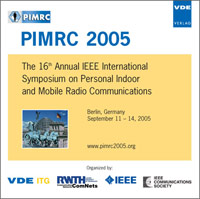Spectrum Load Smoothing for Cognitive Medium Access in Open Spectrum
Conference: PIMRC 2005 - 16th Annual IEEE International Symposium on Personal Indoor and Mobile Radio Communications
09/11/2005 - 09/14/2005 at Berlin, Germany
Proceedings: PIMRC 2005
Pages: 6Language: englishTyp: PDF
Personal VDE Members are entitled to a 10% discount on this title
Authors:
Berlemann, Lars; Hiertz, Guido R.; Walke, Bernhard H. (Chair of Communication Networks, RWTH Aachen University, Germany)
Mangold, Stefan (Swisscom Innovations, Berne, Switzerland)
Abstract:
Today’s framework for radio spectrum regulation and the way the usage of radio spectrum is coordinated, is undergoing vital changes. In the face of scarce radio resources, regulators, industry, and the research community are initiating promising approaches towards a more flexible spectrum usage, referred to as open spectrum. In this paper we discuss medium access control protocols for spectrum agile radios that opportunistically use spectrum, also referred to as "cognitive radio". Spectrum agile radios operate in parts of the spectrum originally licensed to other radio services. They identify free spectrum, coordinate its usage and release it when this is required by licensed radio systems. The application of "waterfilling" from the information theory, referred to as Spectrum Load Smoothing (SLS), and its realization in IEEE 802.11e-based spectrum agile wireless networks is examined in this paper. The SLS, as intelligent principle of spectrum usage, targets at the distributed quality-of-service support in scenarios of coexisting spectrum agile radios. With SLS, spectrum agile radios observe the past usage of the spectrum, while at the same time a harmful interference to license holding radio systems is avoided. The SLS can therefore be referred to as cognitive medium access. In this paper, the capability to support quality-of-service in the presence of other, competing spectrum agile networks and the protection of licensed radio networks are evaluated with the help of simulation. The efficiency of SLS for open spectrum access is demonstrated.


